SIM2 Grand Cinema C3X 1080 DLP Projector Review
SIM2 Grand Cinema C3X 1080 DLP Projector
Is SIM2's Grand Cinema C3X 1080 the best projector we've ever reviewed?
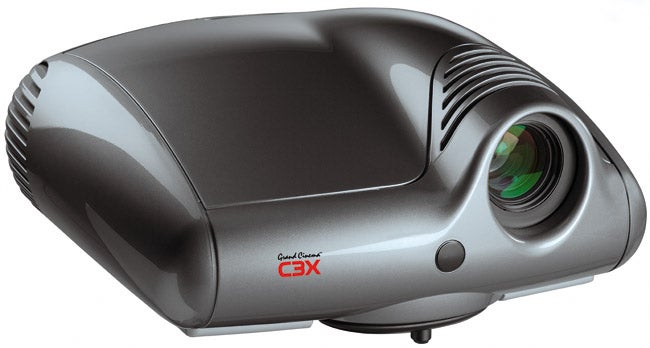
Verdict
Key Specifications
- Review Price: £20000.00
Originally, I hadn’t planned to review SIM2’s C3X 1080 projector today; instead I’d got one of Toshiba’s new Resolution+ TVs lined up. But then it tickled me to think that if I did the C3X 1080 today, we’d have reviews of a £440 projector (Epson’s EH-TW420) and a £20,000 projector right next to each other, amply illustrating the rich diversity currently at play in the world of home video. So here’s the C3X 1080 – in all of its almost unbelievable glory.
The first thing to say, of course, is that £20k really is an extraordinarily large amount of money. It could buy you and your other half a holiday to the Maldives for three years in a row. It could buy you a brand new two-litre Audio A3 SE, or a 2005 Porsche Boxster 3.2 S Coupe with 39,000 miles on the clock. In fact, if the credit crunch continues to have its wicked way with us, the C3X 1080 might even be worth more than a snug flat overlooking a derelict shopping centre in Manchester’s Moss Side.
All of which begs one obvious question: just how in the world can the C3X 1080 possibly justify such an outrageous price when you think what else the money could get you? (Moss Side flat excepted…)
The first big part of the C3X 1080’s answer is the fact that it’s a three-chip DLP model with a Full HD resolution. This matters, in case you’re not particularly familiar with DLP technology, because the use of three separate DLP chipsets – one each for red, green and blue duties – removes the need for the colour wheel arrangement found in single-chip projectors. And since there’s no colour wheel, there’s also no possibility of the picture being affected by the rainbow effect problem (stripes of pure red, green and blue flitting around over the picture) that afflicts all single-chip DLP projectors to some extent. Nor will there be any sign of the dotty noise that can trouble single-chip projectors when trying to show skin tones passing across the screen.
In other words, three-chip DLP projectors, while expensive to make – especially in a Full HD configuration – deliver all the traditional strengths of DLP technology, including fast response times, deeper black levels and richer colour palettes, without any of the usual weaknesses.
Still, tantalising though this sounds, £20k is still pretty steep even by three-chip DLP standards. So it’s just as well that the C3X has plenty more high-end treats up its sleeves.
Probably the single most important of these is the projector’s truly extreme colour management system. Even just working through the options built into the projector’s onscreen menus reveals a staggering amount of flexibility, with six primary presets including Native, HDTV, EBU, SMPTE-C, Auto, and the slightly mysterious-sounding LCC-1. More on this presently. Joining these presets is an extensive list of white point presets too, including standard, high, medium, low, Native, D75, D65, D50, and C options. Plus there’s a User option enabling you to adjust the white point to suit yourself using a simple double-axis graphical interface.
But even this is barely the tip of the colour management iceberg. For the LCC-1 preset slot I mentioned earlier can be used for storing settings calibrated to absolute precision via a combination of a colour meter and remarkably sophisticated software package.
When I said ‘absolute precision’ back there, I meant it. For during a two-hour process, the SIM2 representative who installed my test C3X 1080 was able to tweak the tones of the primary and secondary colours to a point so close to perfection – as defined by the independent, ‘objective’ colour meter and PC software – that any differences were negligible.
It really is very important that I convey fully what this means. For what many people fail to realise is that although a projector of the C3X 1080’s stature naturally ships with its colours pre-calibrated to be as accurate as possible, the actual final tone of the colours you see at home is affected by the environment you’re using your projector in. Factors like the type of screen fabric you’ve got and the amount and type of reflections cast around your room when the projector is working can have a really quite profound impact on the final colour tones you see.
As a result, the only way to ensure that you ultimately get accurate colour tones from even the most expensive projector is to tweak the settings via a colour management system once the projector is installed in its final position in your home. And from having looked on in awe for the full two hours of the C3X 1080 colour calibration process, I can assure you that I’ve never seen another colour calibration system as effective and subtle as that supported by this SIM2 model. Its attention to detail is almost obsessive compulsive in its precision, in fact – and in a high-end home cinema context, that’s about as high a compliment as I can pay!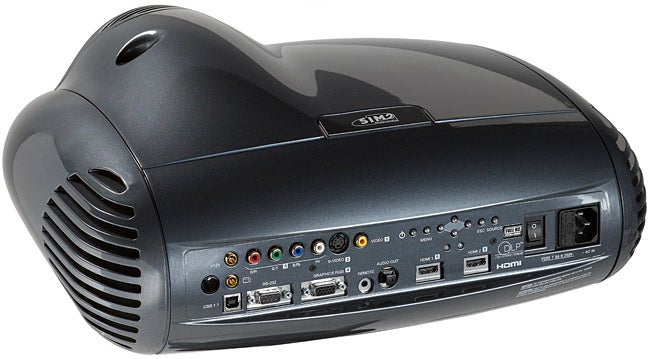
Obviously colour management at this level goes rather beyond the likely domain of a simple owner installation. But it’s meat and drink to a high-end custom installer, and so should make the C3X 1080 a real favourite among the installation fraternity.
We’re nowhere near the end of the C3X 1080’s charms yet, either. For instance, it can deliver a strikingly high typical contrast ratio of 10,000:1 or more, given extra snap by the projector’s exceptional brightness – a brightness that owes much of its quality to SIM2’s AlphaPath Light Engine technology.
Also impressive is the projector’s 10-bit video processing, complete with high-definition scaling and de-interlacing capabilities, and the ability to deliver more than one billion colours on-screen. Allegedly. I have to admit that I didn’t actually count all the potential shades myself!
The C3X 1080’s extreme attention to detail is evident in other aspects of its setup procedure, too. For instance, there are no less than three different lens options: the T1 short throw (1.3-1.7:1), the T2 long-throw standard (1.7-2.6:1), and the T3 long-throw (2.6-3.5:1).
Vertical image shifting is possible, meanwhile, via a simple twisting knob on the projector’s top; the projector ships with a variety of test signals onboard; there’s extensive keystone correction; and you can even choose between five different lamp power settings – a substantial improvement over the simple ‘high’ or ‘low’ settings found on most projectors that offer any lamp adjustment flexibility.
For the record, we generally used the lowest brightness setting during our tests, partly because this seemed to suit the picture best, and partly because switching to higher brightness levels considerably ups the amount of fan noise the C3X 1080 emits.
More hot news about the C3X 1080 that further explains its price is its use of the very latest 0.95in 1080p DarkChip4 DLP chipsets from Texas Instruments – chipsets we’ve already seen deliver superb results on single-chip projectors.
One final key feature of the C3X 1080 is that it looks absolutely lovely. For starters, it’s comfortably the smallest 1080p three-chip DLP projector around. But it’s also beautifully sculpted, terrifically robust, and wrapped up by one of the glossiest finishes we’ve seen. What’s more, although the C3X 1080 is available in High-Gloss Gunmetal as standard, you can also order it in black, red and (bling!) gold.
Probably the least interesting thing about the C3X 1080’s specification is its connectivity. Not because it’s bad, or anything; in fact, with its two HDMIs, component video support, PC jack, RS-232 jack and USB 1.1 port (among others), it’s actually quite well connected. But it’s not as outrageously ahead of the pack in this area as it is in every other.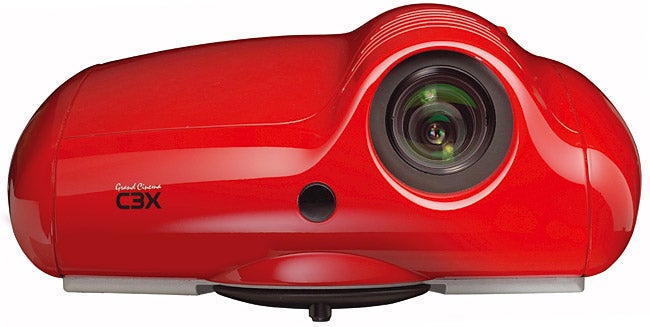
The only tiny twinge of disappointment I felt during my extensive exploration of the C3X 1080’s features was the fact that its scaling engine is a customised PixelWorks DNX affair. There’s nothing wrong with this to some extent; in fact we’ve been very impressed by this system’s work on far cheaper projectors such as the InFocus IN82. But I’d kind of expected something truly high-end from the C3X 1080’s processing, such as, say, an uncompromising Gennum system.
As I finally settled down to watch the C3X 1080, it was clear that I’d have to be absolutely blown away by its performance if the £20k price tag wasn’t going to become a real problem. Luckily, blown away is precisely what I was.
The best way to start describing my experience is to say that the C3X 1080’s pictures are quite simply the most superlatively natural images I have ever seen from a home video projector.
Not surprisingly, the single most important factor in achieving this are the C3X 1080’s amazingly consistent, well-balanced, authentic and expressive colours. In other words, the extraordinary colour management system works so well that I’m now probably going to be permanently disappointed by the colour of every other projector that comes my way.
The C3X 1080’s colour tones are actually outstanding right out of the box, even before you do the whole colour calibration thing. But even so, once they have been fully calibrated, the level of improvement is startling.
It’s not just the tone of the C3X 1080’s colours that impress, either. Also exemplary is the subtlety of the colour blends, especially when it comes to portraying notoriously tricky skin tones. This contributes massively to the overall sense of naturalism I mentioned previously, as well as giving pictures a strikingly three-dimensional feel compared with most rivals.
Amazing, too, is the C3X 1080’s black level response. Dark scenes enjoy some of the very deepest black levels I’ve seen, yet the inky blackness also contains exceptional amounts of shadow detail thanks to the C3X 1080’s ability to combine great black levels with really bright image elements simultaneously within the same frame.
This sort of effortless single-frame dynamism is traditionally one of the things that most sets premium projectors apart from budget models, yet I’ve never seen even another premium projector deliver as much dynamism as the C3X 1080 without looking forced or harsh.
The C3X 1080’s Full HD nature and three-chip stability, meanwhile, enables it to reproduce HD details with outstanding accuracy and not a trace of video noise. Add this almost celluloid-like sharpness to the other talents I’ve noted, and you’ve got yourself a picture so cinematic and engrossing that I honestly believe you’ll never feel the need to actually go out to see a film again.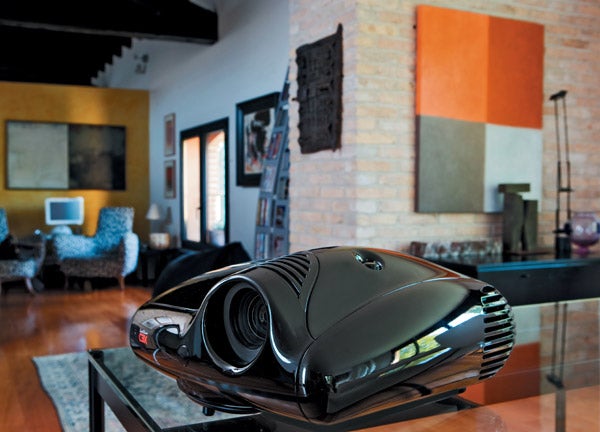
It’s well worth stressing before I’m done just how refreshing it is to be able to watch films on the three-chip C3X 1080 without suffering the rainbow effect and motion noise found with single-chip DLP projectors. In fact, the three-chip system is also likely responsible for the remarkably fluidity and clarity of the C3X 1080’s motion reproduction – something that’s achieved, it’s important to note, without any heavy-handed image processing and resulting artefacts. This strength is particularly notable when watching Blu-rays.
If I had to find one area where the C3X 1080 could possibly be improved, it would be its standard definition performance. For while the PixelWorks processing system certainly works well, the C3X 1080’s price doesn’t bag you the same level of sharpness and upscaling cleanliness witnessed via good standalone video processors like the recently tested DVD0 VP50 Pro.
”’Verdict”’
If you happen to have 20 grand lying about looking for a home, I strongly suggest that you forget all about those second-hand Porsche and Maldives holiday plans, and focus instead on the truly jaw-dropping SIM2 C3X 1080. Especially since if you’ve got £20k spare, you’ll almost certainly also have or be able to get all the lovely HD sources necessary to get the best from what is, when all’s said and done, the finest projector I’ve ever seen.
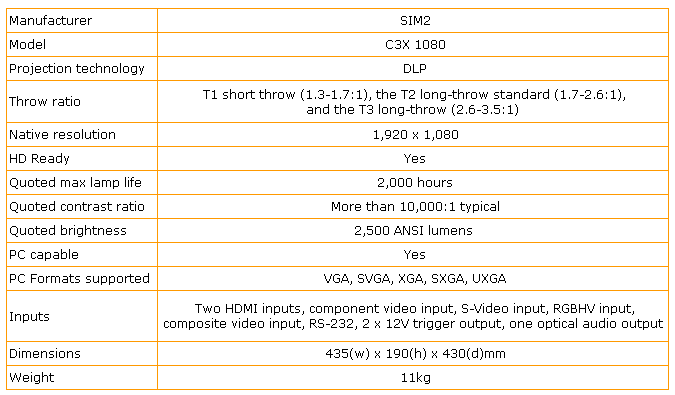
Trusted Score
Score in detail
-
Value 9
-
Features 10
-
Image Quality 10
-
Design 9

